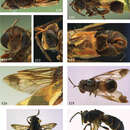Masarygus: Brief Summary
provided by wikipedia EN
Masarygus is a genus of hoverflies native to Argentina, containing two species. It was first described as representing a new family related to Conopidae or possibly the Oestridae due to its much reduced mouthparts. Larvae are found in ant nests.
- license
- cc-by-sa-3.0
- copyright
- Wikipedia authors and editors
Description
provided by Zookeys
Body length: 4–7 mm. Small, delicate flies with long antennae and flat abdomen. Head slightly to much wider than thorax. Face concave, either entirely or only laterally; wider than an eye. Mouth parts undeveloped: oral opening absent or hardly visible. Vertex more or less flat, not strongly produced or convex. Occiput ventrally narrow or widened, dorsally widened. Eye bare. Eyes in male not converging at level of frons, with mutual distance about 4 times the width of antennal fossa. Antennal fossa about as wide as high or about 1.5 times as wide as high. Antenna as long as or longer than distance between antennal fossa and anterior oral margin; basoflagellomere longer than scape, multifurcate in male (3 to 14 branches), unfurcate in female; bare; arista absent in male, present in female. Postpronotum bare. Scutellum semicircular; without calcars. Anepisternum convex; entirely with sparse, bristle-like pile. Anepimeron bare or pilose. Katepimeron convex; bare; with or without wrinkled texture. Wing: vein R4+5 without posterior appendix; vein M1 perpendicular to vein R4+5; postero-apical corner of cell r4+5 widely rounded or rectangular, with or without small appendix; crossvein r-m located very close to base of cell dm (within basal 1/10). Abdomen dorsoventrally flattened; more or less trapezoid, with lateral margins gradually widening posteriad, with largest width at tergite 4; 1.5-2.5 times as long as wide. Tergites 3 and 4 fused. Male genitalia: phallus furcate near apex, straight, projecting not or hardly beyond apex of hypandrium; epandrium without ventrolateral ridge; surstylus unfurcate, more or less oval.
- license
- cc-by-3.0
- copyright
- Menno Reemer, Gunilla Ståhls
- bibliographic citation
- Reemer M, Ståhls G (2013) Generic revision and species classification of the Microdontinae (Diptera, Syrphidae) ZooKeys 288: 1–213
- author
- Menno Reemer
- author
- Gunilla Ståhls
Distribution
provided by Zookeys
Described species: 2. Neotropical. At least two undescribed species are known to occur (see Discussion). All species known so far, including the undescribed ones, have only been collected on one occasion.
- license
- cc-by-3.0
- copyright
- Menno Reemer, Gunilla Ståhls
- bibliographic citation
- Reemer M, Ståhls G (2013) Generic revision and species classification of the Microdontinae (Diptera, Syrphidae) ZooKeys 288: 1–213
- author
- Menno Reemer
- author
- Gunilla Ståhls

